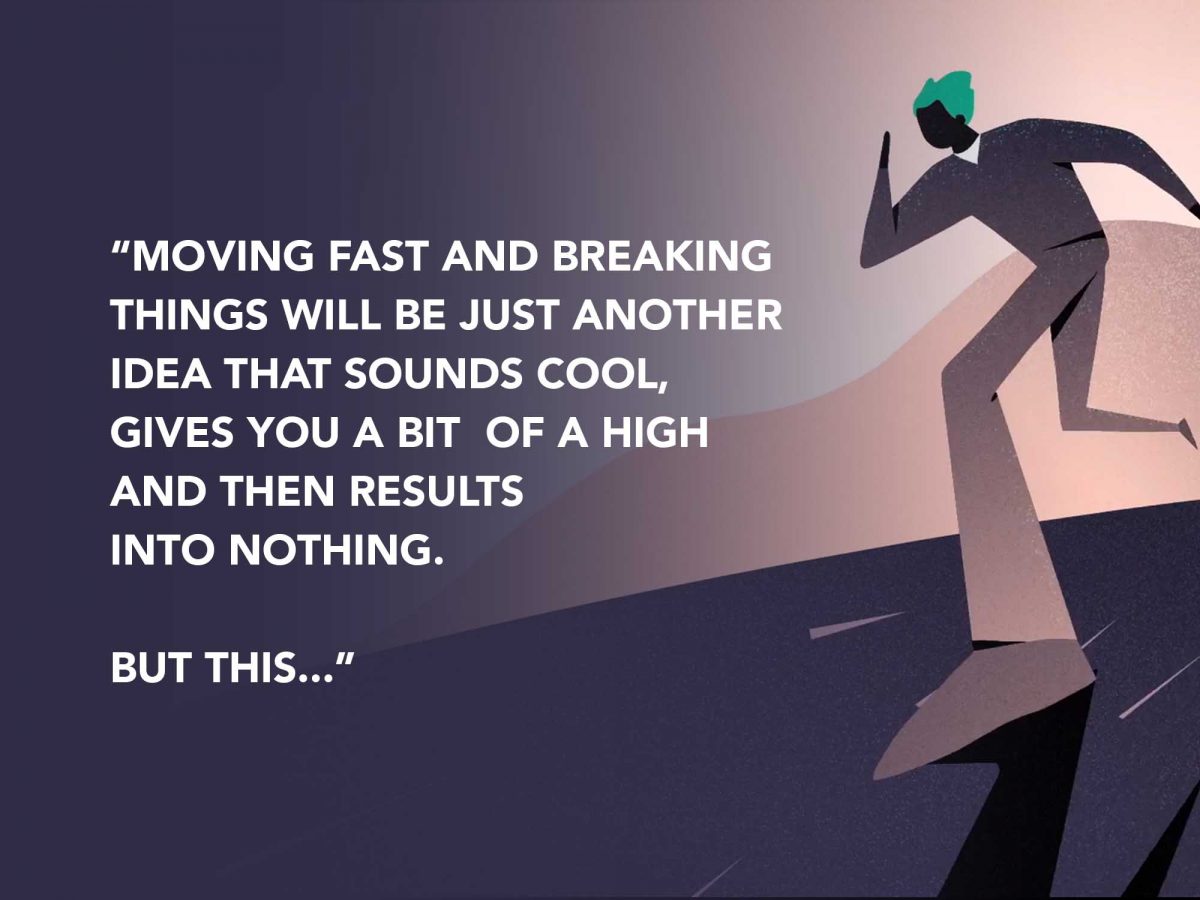The reason why disruption happens or why big companies fall and newcomers and break through is simple.
Simple but definitely not easy: we overthink.
It’s a natural state of mind, it’s a human tendency. And we’ve got less to lose when we’ve just started, so it’s easier to overcome overthinking. Once we’re big, it’s way harder.
Which is one of the reasons why cycles happen.
You traded overthinking for speed (good thing!), got bigger, became slower so you’ll be back at square one. And that’s not a bad thing, by the way. It’s nature’s way of teaching us — or rather, our way of teaching ourselves.
Let’s head to SaaS
In this field, we’re psychologically prone to overthink since we’re talking about analytical people. If you think that’s a negative consequence, you’ve never been wronger.
It’s 10x better to be at this end of the interval, hyper-analytical and prone to overthinking, than at the opposite. Everything is good under the sun.
But what can we do about it? Easy: understand how much more important moving fast is over thinking 10 times the amount of time needed to make a decision.
Here’s the very important deal.
You’ve heard “Move fast and break things” which is the dreamy-pinky world-saving statement from Facebook (not Google, like in the tweet).
The deal is this: moving fast and breaking things is available when you come from a hyper-analytical place. It’s bad advice otherwise and it’s some sort of a life/universe rule that you’ve got two choices when you give advice:
- Either give advice that sounds good overall, but it’s not contextual at all. People can take them as mantras, as 10 people will understand 14 different meanings. So more meanings will apply to more people, therefore more will become “woke”.
- Actually help someone and make it contextual. But you’re making a trade: you need to renounce this piece of advice that will become your next coin at the “social media influencer” game or “business expert” title.
In other words: either make it widely-available so that it sounds cool and more people adopt it. Or make it contextual and truly help people. In my opinion, everyone should dance with both.

Back to my idea, moving fast helps a lot if you’re usually stuck. If you’re the type who can’t truly commit to any professional endeavour, moving fast and breaking things will be just another idea that sounds cool, gives you a bit of a high and then results into nothing.
That was the context I was making for my point. Now, the point:
Making a decision in 1/10 of the time you would usually take for thinking about it all the way through is faster than:
- Thinking a lot of time
- Going with a decision that comes out of pressure
- Always thinking about the alternative
- Because of #3, your day-to-day activity is slowed down
What I’m saying we should be doing is:
- Take 1/10 of the time you’d usually take to think. Think it.
- Go with it
- If all’s good, congrats
- If it’s not, you now have more time than alternative #1 to fix it.
Here’s another highlight:
If it requires 5 sessions of fixing on route #2 (the fast one), you would have anyways only reduced that number to 4 sessions of fixing, should you’ve gone with the route #1 (the slow one).
Personally
I’m trying to expose myself in a quest of self-awareness and in the best case scenario I’ll lead the way for yourself to start doing it as well. Not in front of others but in front of yourself.
Very few people get to a maximum level of self-awareness and you’d call them enlightened (or so they say) — I don’t know much about that but I know that if you’re able to see things within yourself, you’ll be better.
Here’s my position and again, I’m hoping it’ll make it easier for you to talk to yourself about it.
Personally, I still struggle with this and even though I’m hoping it’ll go away at one point, something tells me it’s normal to have it for the rest of your life. It’s just that you overcome it faster and faster.
Like fear, it never goes away. I even said it myself that it’s a human tendency. Myself, I want to move faster and if I get to that point I’ll want to move even faster.
In all honesty, this article is a message from me to myself. Here’s the addendum of this letter to myself, which is what I bring into my mind when I’m not 100% into the idea.

A short story
Branding matters. UX matters. Where you’ll place a button is important and the colour of it is significant.
We know all that. No doubt about it.
But Phil Knight (founder) et. co didn’t like the Nike swoosh at all first time they saw it. On top of that, they paid $35 for it.
We hear the story and we say wow. I heard it many times, read the book multiple times and even so it was a long way from reading and saying “ha!” to incorporating it in my life.
If the swoosh became that then what the hell are we waiting for.
Much like that feeling before an exam, it wasn’t about the 2 hours prior to it. It was about the days or months of preparation.
The swoosh meant the 2 hours prior to the exam. All other operations and day-to-day stuff along the decades meant the preparation.
About Ch Daniel
I run Chagency_, an experiences design agency — we help SaaS CEOs reduce user churn. I write daily on this topic and in similar areas. Here are my best pieces.
If I’ve helped you, follow me here and reach out: LinkedIn | Twitter | Email | Quora | YouTube
I’ve also founded an app (among others) that has got 6 digits in # of users — chdaniel.com/app
If you want a more of a personal connection, here’s how to have that.
Picture credits: Eduardo Gomes, Man Ki Kim, Run Zebra Run




